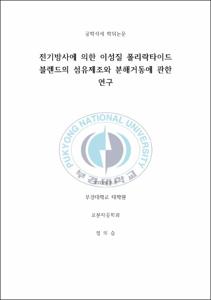전기방사에 의한 이성질 폴리락타이드 블렌드의 섬유제조와 분해거동에 관한연구
- Abstract
- Poly(lactide)s (PLA) are known to be biocompatible, biodegradable and used for medical applications such as drug delivery devices, absorbable sutures, and as a material for medical implants and other related applications. Also, it is attractive in the field of environmental applications because of the problems related to plastic waste accumulation.
The lactide exists in three stereoisomeric configurations: L-lactide, D-lactide, and meso-lactide. PLA with high molecular weight can be synthesized by the ring opening polymerization of cyclic lactide.
PLA stereocomplexes, formed by the mixing of two enantiomers poly(L-lactide) (PLLA) and poly(D-lactide) (PDLA), have many favorable characteristics. The stereocomplex showed a 50 °C higher melting point then that of each enantiomeric polymer. The resistance toward hydrolytic degradation was increased.
In this study, we investigated the influence of the composition and the optical purity of stereochemical PLA blends on the formation of stereocomplexes. Additionally, the nanofiber of stereochemical PLA and their blends were prepared by electrospinning methods. The properties of the obtained fibers were analyzed by differential scanning calorimetry (DSC) and scanning electron microscopy (SEM), the results showed that a degree of stereocomplex was controlled by change of optical purity of each component. The enzymatic degradation of the fibers were studied.
- Issued Date
- 2013
- Awarded Date
- 2013. 8
- Type
- Dissertation
- Publisher
- 부경대학교
- Affiliation
- 대학원
- Department
- 대학원 고분자공학과
- Advisor
- 이원기
- Table Of Contents
- 1.
서론.........................................................................................
1
2.
이론적 배경
2.1.
생분해성 고분자..................................................................
5
2.1.1.
Poly (3-hydroxyalkanoate) (PHA)................................
7
2.1.2.
Poly (glycolic acid) (PGA)...........................................
8
2.1.3.
Poly (ε-caprolactone) (PCL).......................................
9
2.1.4.
Poly (lactic acid) (PLA)..............................................
10
2.2.
PLA
2.2.1.
PLA의 일반적 성질.......................................................
12
2.2.2.
PLA의 응용.................................................................
13
2.3
섬유의 분류........................................................................
16
2.4
전기 방사법
2.4.1.
전기 방사법.................................................................
17
2.4.2.
용융 전기 방사.............................................................
18
2.4.3.
용액 전기 방사.............................................................
19
2.4.4.
전기 방사의 원리.........................................................
20
2.4.5.
전기 방사의 공정 변수..................................................
24
3.
실험
3.1.
Stereochemical PLA
3.1.1.
재료............................................................................
26
3.1.2.
Stereochemical PLA의 합성........................................
26
3.2.
Stereochemical PLA의 블렌드
3.2.1.
재료............................................................................
27
3.2.2.
Stereochemical PLA의 블렌드 제조..............................
27
3.3.
전기방사 섬유
3.3.1
재료............................................................................
28
3.3.2
전기방사 섬유의 제조...................................................
28
3.4.
섬유의 분해
3.4.1
재료............................................................................
29
3.4.2
섬유의 분해 특성.........................................................
29
3.5.
특성 분석...........................................................................
30
4.
결과 및 고찰
4.1.
Stereochemical PLA의 특성..................................................
31
4.2.
전기방사 섬유
4.2.1.
전압이 용액 전기방사에 미치는 영향.................................
34
4.2.2.
노즐 직경이 용액 전기방사에 미치는 영향..........................
36
4.3.
L100/D100 블렌드 조성에 따른 특성
4.3.1.
열적 특성.......................................................................
38
4.3.2.
효소에 의한 분해 거동.....................................................
41
4.4.
Stereochemical PLA 블렌드의 특성
4.4.1.
열적 특성.......................................................................
48
4.4.2.
효소에 의한 분해 거동.....................................................
52
5.
결론.......................................................................................
56
6.
참고 문헌................................................................................
57
- Degree
- Master
- Files in This Item:
-
-
Download
 전기방사에 의한 이성질 폴리락타이드 블렌드의 섬유제조와 분해거동에 관한연구.pdf
기타 데이터 / 1.58 MB / Adobe PDF
전기방사에 의한 이성질 폴리락타이드 블렌드의 섬유제조와 분해거동에 관한연구.pdf
기타 데이터 / 1.58 MB / Adobe PDF
-
Items in Repository are protected by copyright, with all rights reserved, unless otherwise indicated.